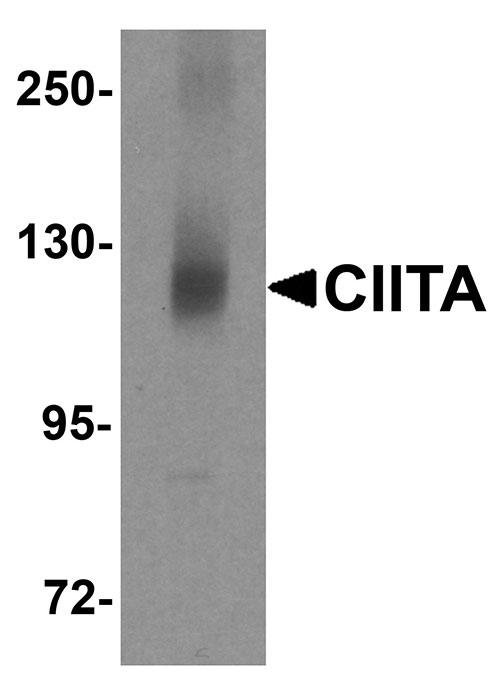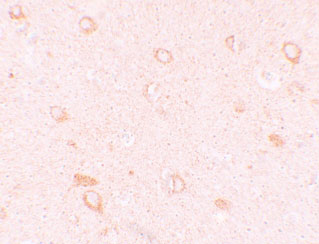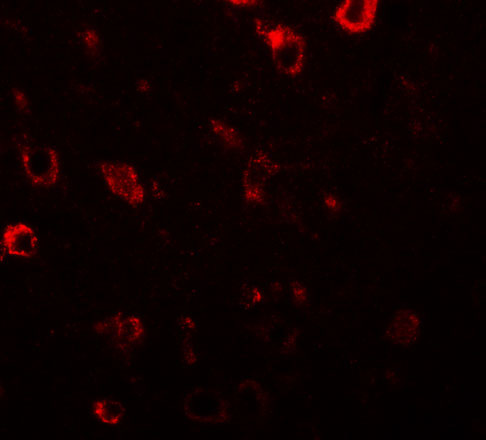CIITA Antibody
- 产品详情
- 实验流程
- 背景知识
Application
| WB, IF, E, IHC-P |
|---|---|
| Primary Accession | P33076 |
| Other Accession | P33076, 218511957 |
| Reactivity | Human, Mouse, Rat |
| Host | Rabbit |
| Clonality | Polyclonal |
| Isotype | IgG |
| Calculated MW | 123415 Da |
| Concentration (mg/ml) | 1 mg/mL |
| Conjugate | Unconjugated |
| Application Notes | CIITA antibody can be used for detection of CIITA by Western blot at 1 µg/mL. Antibody can also be used for immunohistochemistry starting at 10 µg/mL. For immunofluorescence start at 20 µg/mL. |
| Gene ID | 4261 |
|---|---|
| Other Names | MHC class II transactivator, CIITA, 2.3.1.-, 2.7.11.1, CIITA, MHC2TA |
| Target/Specificity | CIITA; |
| Reconstitution & Storage | CIITA antibody can be stored at 4℃ for three months and -20℃, stable for up to one year. As with all antibodies care should be taken to avoid repeated freeze thaw cycles. Antibodies should not be exposed to prolonged high temperatures. |
| Precautions | CIITA Antibody is for research use only and not for use in diagnostic or therapeutic procedures. |
| Name | CIITA (HGNC:7067) |
|---|---|
| Synonyms | MHC2TA |
| Function | Essential for transcriptional activity of the HLA class II promoter; activation is via the proximal promoter (PubMed:16600381, PubMed:17493635, PubMed:7749984, PubMed:8402893). Does not bind DNA (PubMed:16600381, PubMed:17493635, PubMed:7749984, PubMed:8402893). May act in a coactivator-like fashion through protein-protein interactions by contacting factors binding to the proximal MHC class II promoter, to elements of the transcription machinery, or both PubMed:8402893, PubMed:7749984, (PubMed:16600381, PubMed:17493635). Alternatively it may activate HLA class II transcription by modifying proteins that bind to the MHC class II promoter (PubMed:16600381, PubMed:17493635, PubMed:7749984, PubMed:8402893). Also mediates enhanced MHC class I transcription; the promoter element requirements for CIITA-mediated transcription are distinct from those of constitutive MHC class I transcription, and CIITA can functionally replace TAF1 at these genes. Activates CD74 transcription (PubMed:32855215). Exhibits intrinsic GTP- stimulated acetyltransferase activity (PubMed:11172716). Exhibits serine/threonine protein kinase activity: can phosphorylate the TFIID component TAF7, the RAP74 subunit of the general transcription factor TFIIF, histone H2B at 'Ser-37' and other histones (in vitro) (PubMed:24036077). Has antiviral activity against Ebola virus and coronaviruses, including SARS-CoV-2 (PubMed:32855215). Induces resistance by up-regulation of the p41 isoform of CD74, which blocks cathepsin-mediated cleavage of viral glycoproteins, thereby preventing viral fusion (PubMed:32855215). |
| Cellular Location | Nucleus. Nucleus, PML body. Note=Recruited to PML body by PML |
For Research Use Only. Not For Use In Diagnostic Procedures.
Provided below are standard protocols that you may find useful for product applications.
BACKGROUND
CIITA Antibody: CIITA contains an acidic transcriptional activation domain, four LRRs (leucine-rich repeats) and a GTP binding domain. It is located in the nucleus and acts as a positive regulator of class II major histocompatibility complex gene transcription, and is referred to as the "master control factor" for the expression of these genes. CIITA also binds GTP and uses GTP binding to facilitate its own transport into the nucleus. Once in the nucleus it does not bind DNA but rather uses an intrinsic acetyltransferase (AT) activity to act in a coactivator-like fashion. Mutations in this gene have been associated with bare lymphocyte syndrome type II (also known as hereditary MHC class II deficiency or HLA class II-deficient combined immunodeficiency), increased susceptibility to rheumatoid arthritis, multiple sclerosis, and possibly myocardial infarction.
REFERENCES
LeibundGut-Landmann S, Waldburger JM, Krawczyk M, et al. Mini-review: specificity and expression of CIITA, the master regulator of MHC class II genes. Eur. J. Immunol. 2004; 34:1513-25.
Harton JA, Cressman DE, Chin KC, et al. GTP binding by class II transactivator: role in nuclear import. Science 1999; 285:1402-5.
Raval A, Howcroft TK, Weissman JD, et al. Transcriptional coactivator, CIITA, is an acetyltransferase that bypasses a promoter requirement for TAF(II)250. Mol. Cell 2001; 7:105-15.
Inohara C, McDonald C, and Nunez G. NOD-LRR proteins: role in host-microbial interactions and inflammatory disease. Annu. Rev. Biochem. 2005; 74:355-83.
终于等到您。ABCEPTA(百远生物)抗体产品。
点击下方“我要评价 ”按钮提交您的反馈信息,您的反馈和评价是我们最宝贵的财富之一,
我们将在1-3个工作日内处理您的反馈信息。
如有疑问,联系:0512-88856768 tech-china@abcepta.com.























 癌症的基本特征包括细胞增殖、血管生成、迁移、凋亡逃避机制和细胞永生等。找到癌症发生过程中这些通路的关键标记物和对应的抗体用于检测至关重要。
癌症的基本特征包括细胞增殖、血管生成、迁移、凋亡逃避机制和细胞永生等。找到癌症发生过程中这些通路的关键标记物和对应的抗体用于检测至关重要。 为您推荐一个泛素化位点预测神器——泛素化分析工具,可以为您的蛋白的泛素化位点作出预测和评分。
为您推荐一个泛素化位点预测神器——泛素化分析工具,可以为您的蛋白的泛素化位点作出预测和评分。 细胞自噬受体图形绘图工具为你的蛋白的细胞受体结合位点作出预测和评分,识别结合到自噬通路中的蛋白是非常重要的,便于让我们理解自噬在正常生理、病理过程中的作用,如发育、细胞分化、神经退化性疾病、压力条件下、感染和癌症。
细胞自噬受体图形绘图工具为你的蛋白的细胞受体结合位点作出预测和评分,识别结合到自噬通路中的蛋白是非常重要的,便于让我们理解自噬在正常生理、病理过程中的作用,如发育、细胞分化、神经退化性疾病、压力条件下、感染和癌症。








